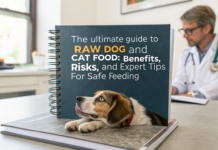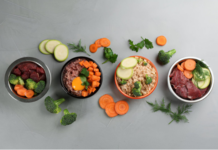Last Updated on June 11, 2024 by Dogs Vets
The debate between traditional kibble and raw dog food in pet nutrition, stirs strong opinions among pet owners and veterinarians alike. As we delve deeper into what fuels our furry friends best, raw dog food often emerges as a contender that may offer superior benefits for your dog’s health and vitality.
For discerning pet owners who aim to provide the best for their dogs, understanding the potential advantages of a raw diet can be a game-changer.
Introduction to Raw Dog Food
Raw dog food typically consists of fresh, uncooked ingredients, including meats, bones, fruits, and vegetables.
This diet seeks to mimic what dogs’ wild ancestors would have eaten, arguing that modern domestic dogs may still thrive on this type of diet. Proponents suggest that without the processing that traditional pet foods undergo, raw food retains more of its natural nutrients, which are essential for your dog’s health.
Switching to a raw diet isn’t just about tossing raw meat into your dog’s bowl. Raw diets can be purchased pre-made from specialty pet stores or online or prepared at home under the guidance of a veterinary nutritionist.
Benefits of Raw Feeding
One of the most significant reported benefits of feeding raw is the noticeable improvement in a dog’s coat and skin health. Many pet owners observe a shinier coat and less skin irritation after switching to raw food. This could be due to the higher levels of naturally occurring oils and fats in raw meat, often diminished in cooked or processed foods.
Digestive health also improves, as raw diets are often easier for dogs to break down and absorb than commercial kibble. This can lead to smaller, less odorous stools—a plus for any dog owner.
Raw diets may also help maintain better weight control, as they typically contain fewer carbohydrates and fillers than their commercial counterparts.
Dental health is another area where raw food diets may excel. Chewing on raw, meaty bones can help reduce tartar build-up and promote healthier gums, which is essential since dental issues can lead to more serious systemic health problems in dogs.
Understanding Protein Sources in a Raw Diet
When considering a raw diet, the question often arises: “What is the best protein for dogs?” The answer varies depending on your dog’s needs, but common protein sources in raw diets include chicken, beef, lamb, and fish. Each type of meat offers different nutritional benefits and can be a part of a well-rounded diet.
Chicken and beef are excellent protein sources, providing essential amino acids for muscle development and maintenance. Lamb, often used for dogs with allergies to more common meats, offers a good protein alternative and is rich in dietary fats that help sustain energy. Fish, particularly oily types like salmon, are high in omega-3 fatty acids, which support skin, coat, and joint health.
Choosing the right protein for your dog involves considering their activity level, food sensitivities, and overall health. Rotating between different proteins is essential to prevent allergies and ensure a broad range of nutrients. This approach keeps meals interesting for your dog and balances their diet for optimal health.
Balancing the Raw Diet: Vitamins, Minerals, and More
While the focus often lies on protein in a raw diet, vitamins, and minerals are equally vital to ensure your dog’s optimal health. A well-rounded raw diet includes not just muscle meat but also organ meats, bones, and a variety of fruits and vegetables. These components work together to provide a spectrum of essential nutrients.
Organ meats like liver and kidneys are nutrient powerhouses packed with vitamins A, D, E, and K and essential minerals like iron, copper, and zinc. These organs support various bodily functions, including vision, blood health, and immune response. Bones, whole or ground, supply calcium, and phosphorus, crucial for maintaining strong teeth and bones.
Fruits and vegetables, though a smaller component of the diet, are important for providing dietary fiber, which aids digestion, and antioxidants, which help combat free radicals. Items like blueberries, spinach, and carrots can be included to enhance the diet’s nutritional content, ensuring your dog gets a broad range of nutrients necessary for long-term health.
Common Concerns and How to Address Them
If not properly formulated, homemade raw diets can lead to nutritional deficiencies over time. Consulting with your vet or dog nutritionist can help ensure your homemade raw diet meets your dog’s nutritional needs.
There’s also the cost and time investment to consider. Raw diets can sometimes be more expensive than commercial dog foods, and food preparation can be time-consuming.
However, many find these investments worthwhile for the health benefits they see in their pets. Thankfully, ordering raw dog food online is easier than ever today, so you can always take that route and most pet owners do.
For those ready to embrace this natural approach to feeding, the journey towards a raw diet can be a transformative experience, leading to profound benefits and a deeper bond with your pet. Whether through the sparkle in their coat, their robust health, or the joy in their mealtime, the advantages of raw dog food can redefine how you care for your cherished companion.
Fact Check
We strive to provide the latest valuable information for pet lovers with accuracy and fairness. If you would like to add to this post or advertise with us, don’t hesitate to reach us. If you see something that doesn’t look right, contact us!

















